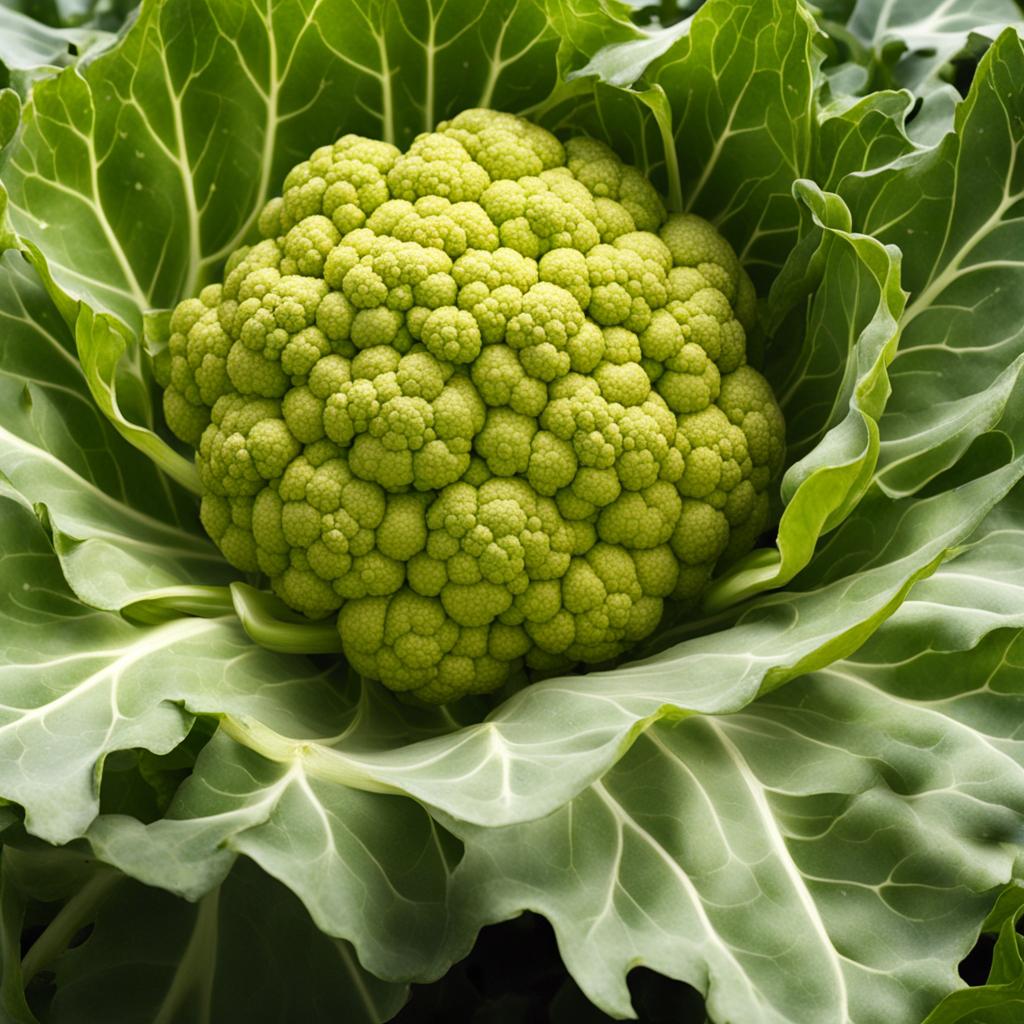As a vegetable lover, I always strive to have the freshest produce in my kitchen. One versatile vegetable that often finds its way into my meals is cauliflower. However, it’s crucial to know how to determine if cauliflower is still good to eat or if it has gone bad. To help you ensure the freshness and quality of your cauliflower, I’ll share some tips to identify signs of spoilage and maintain food safety.
Key Takeaways:
- Fresh cauliflower should be firm, with no smell and free of dark blemishes, mold, and “furry” textures.
- Signs of cauliflower spoilage include mold growth, soft spots, discolored leaves, and a strong or acrid smell.
- Proper storage in the refrigerator, using loose or perforated plastic bags, helps maintain cauliflower’s freshness.
- It is best to discard cauliflower that exhibits signs of spoilage to ensure food safety.
- Trust your senses and pay attention to changes in appearance, texture, and smell to determine if cauliflower is past its prime.
Signs of Rot in Cauliflower
When it comes to cauliflower, it’s important to be able to identify signs of rot or spoilage. By recognizing these indicators early on, you can avoid consuming cauliflower that may pose health risks. Here are some key signs to look out for:
- Mold growth: Mold on cauliflower can appear as dark brown or black spots, or even furry white growth. If you see any signs of mold, it’s best to discard the cauliflower as it is no longer safe to eat.
- Soft spots: If you notice soft or mushy areas on the cauliflower head, it’s a clear indication that it has started to rot. These soft spots can be a breeding ground for bacteria, so it’s best to avoid consuming cauliflower with this texture.
- Discolored leaves: Cauliflower leaves should be a vibrant shade of green. If you see yellow or discolored leaves, especially if they have mold on them, it’s a sign that the cauliflower head is past its prime and may no longer be safe for consumption.
- Unpleasant smell: A strong or acrid smell coming from the cauliflower is another indication that it is no longer fresh. Trust your sense of smell and if the cauliflower has a foul odor, it’s best to discard it.
By keeping an eye out for these signs, you can ensure that you only consume fresh and safe cauliflower. It’s always better to be cautious and discard any cauliflower that exhibits these indicators of rot.
| Signs of Rot in Cauliflower | Action |
|---|---|
| Mold growth | Discard the cauliflower |
| Soft spots | Do not consume |
| Discolored leaves | Avoid consumption |
| Unpleasant smell | Discard the cauliflower |
The Best Way to Store Cauliflower
Proper storage is key to maintaining the freshness and quality of cauliflower. Storing cauliflower correctly will help extend its shelf life and ensure that it remains crisp and flavorful. The best way to store cauliflower is in the refrigerator.
To store cauliflower, it is recommended to place it in a loose or perforated bag. This allows for some air movement, preventing moisture buildup and reducing the risk of spoilage. Keeping cauliflower dry is essential, as moisture can promote the growth of mold or cause the vegetable to become slimy.
A whole head of cauliflower can be stored in the refrigerator for 5-6 days. Precut florets, on the other hand, should be consumed within 4 days to maintain their optimal quality. It is important to note that the shelf life of cauliflower may vary depending on factors such as temperature and humidity levels in your refrigerator.
| Storage Method | Shelf Life |
|---|---|
| Whole head of cauliflower | 5-6 days |
| Precut cauliflower florets | Up to 4 days |
Remember to keep cauliflower away from strong-smelling foods, as it can absorb odors easily. If you’re unable to use your cauliflower before it starts to deteriorate, consider freezing it. Frozen cauliflower can last for up to a year when stored in an airtight container. However, keep in mind that freezing may cause some changes in texture and flavor.
By following these storage tips, you can enjoy fresh and delicious cauliflower for an extended period of time. So, next time you buy cauliflower, make sure to store it properly to maintain its quality and maximize its shelf life.
How Long Does Cauliflower Keep in the Fridge?
When it comes to storing cauliflower in the fridge, the shelf life can vary depending on the storage conditions. A whole head of cauliflower can last for 5-6 days when properly stored in the refrigerator. However, it’s important to note that the way you store cauliflower can greatly impact its longevity.
If you choose to store cauliflower in a tight plastic bag with no air movement, it may start to go bad after only 3 days. This is because the lack of air circulation promotes moisture buildup, which can accelerate spoilage. To prolong the shelf life of cauliflower, it’s best to use a loose or perforated plastic bag. This allows for some air movement, preventing excess moisture and helping the cauliflower stay fresh for longer.
Proper refrigeration and storage conditions are key to maintaining the freshness of cauliflower. By ensuring air movement and avoiding tight plastic bags, you can extend the shelf life of cauliflower to enjoy its flavors and nutritional benefits for up to 5-6 days.
Can You Cut the Dark Spots off Cauliflower?
When it comes to cauliflower, it’s not uncommon to find some light brown spots on the surface. These spots are typically caused by oxidization and can be trimmed off without impacting the overall quality or taste of the cauliflower. However, it’s important to differentiate between light brown spots and dark brown or black spots.
Light brown spots are a result of the cauliflower interacting with the air, similar to how an apple turns brown when cut. These spots can be safely removed by cutting off the affected areas. The remaining cauliflower is still edible and can be used in your favorite recipes.
On the other hand, dark brown or black spots on cauliflower indicate the presence of mold or spoilage. If you notice these spots, along with a bad smell, mushy texture, or signs of mold growth, it’s best to discard the cauliflower. Consuming cauliflower with mold or spoilage can lead to foodborne illnesses and should be avoided for safety reasons.
When preparing and cooking cauliflower, it’s always important to examine it closely for any signs of spoilage. By being aware of the difference between light brown spots and dark brown or black spots, you can ensure that you are enjoying fresh and safe cauliflower in your meals.
“Light brown spots can be safely removed by cutting off the affected areas.”
| Signs of Cauliflower Spoilage | Action to Take |
|---|---|
| Light brown spots | Trim off the affected areas and use the remaining cauliflower. |
| Dark brown or black spots | Discard the cauliflower to avoid consuming mold or spoiled cauliflower. |
| Bad smell, mushy texture, signs of mold growth | Discard the cauliflower to prevent foodborne illnesses. |
Do You Need to Store Cauliflower in the Fridge?
When it comes to storing cauliflower, refrigeration is the best option to maintain its freshness and extend its shelf life. Storing cauliflower in the refrigerator helps to slow down the natural deterioration process and prevent spoilage. It is recommended to place the cauliflower in a loose or perforated plastic bag to allow for some air movement while keeping it dry. This helps to maintain the vegetable’s quality and texture.
However, if you find yourself unable to store cauliflower in the fridge, don’t worry! Cauliflower can also be frozen and will keep for up to a year in the freezer. Freezing cauliflower is a great way to preserve its freshness for future use. Before freezing, it’s important to properly wrap the cauliflower or store it in an airtight container to prevent freezer burn and maintain its flavor.
Whether you choose to store cauliflower in the refrigerator or freeze it, always remember to label and date the package to keep track of its freshness. This will help ensure that you use the cauliflower within the recommended storage time for the best taste and quality.
Overall, refrigeration is the preferred method to store cauliflower and maintain its freshness. However, freezing is a viable option if fridge storage is not available. With proper storage, you can enjoy delicious cauliflower throughout the year, whether it’s freshly refrigerated or conveniently frozen.
Is Cauliflower with a Bad Smell Okay to Eat?
When it comes to determining the edibility of cauliflower, the smell is a crucial factor to consider. While it is normal for cooked cauliflower to have a distinct odor, a strong, acrid, or ammonia-like smell from uncooked cauliflower is a clear indication that it is past its prime and should not be consumed. The presence of such a strong odor suggests that the cauliflower has started to spoil and may not be safe to eat.
It’s important to note that fresh cauliflower should not have a strong smell when uncooked. If you detect an unpleasant odor, it is advisable to discard the cauliflower to avoid any potential health risks. Trusting your sense of smell is vital in ensuring the safety and quality of your cauliflower.
“Cauliflower with a strong, acrid, or ammonia-like smell should not be eaten as it is a sign that it is past its prime.”
Properly inspecting the smell of cauliflower is a simple yet effective way to identify if it has gone bad. By being mindful of any strong, unpleasant odors, you can ensure that you’re consuming fresh and safe cauliflower.
| Caution: | Uncooked cauliflower with a strong, acrid, or ammonia-like smell is not safe to eat. |
|---|---|
| Tip: | Trust your sense of smell when determining the freshness of cauliflower. |
Remember, a bad smell is a clear indicator that cauliflower is no longer suitable for consumption. It is always better to err on the side of caution and discard cauliflower with a strong, acrid, or ammonia-like smell.
Summary
- If uncooked cauliflower has a strong, acrid, or ammonia-like smell, it is past its prime and should not be eaten.
- Fresh cauliflower should not have a strong smell when uncooked.
- Trust your sense of smell to ensure the safety and quality of your cauliflower.
- Discard cauliflower with a strong, acrid, or ammonia-like smell to avoid potential health risks.
How to Tell the Difference Between Oxidization and Mold on Cauliflower?
When examining cauliflower for signs of spoilage, it is important to distinguish between oxidization and mold. Oxidization occurs when the cauliflower reacts with air, resulting in light brown spots on the vegetable’s surface. These spots are harmless and can be safely trimmed away before consumption. However, mold growth on cauliflower is a clear indication of spoilage and should prompt immediate disposal.
To identify oxidization, look for light brown spots that are evenly spread across the cauliflower. These spots may appear as discolorations or slight browning. By simply trimming away the affected areas, you can enjoy the rest of the cauliflower without any concerns. However, it is essential to remember that the remainder of the cauliflower should be crisp, firm, and have no visible signs of mold or other spoilage.
In contrast, mold on cauliflower appears as dark brown or black spots with a furry texture. These spots may be concentrated in certain areas or cover the entire surface of the vegetable. If you detect any mold growth on your cauliflower, it is crucial to discard the entire head. Consuming cauliflower with mold can lead to adverse health effects and should be avoided.
Table: Comparing Oxidization and Mold on Cauliflower
| Factor | Oxidization | Mold |
|---|---|---|
| Color | Light brown spots | Dark brown or black spots |
| Texture | Surface discoloration | Furry texture |
| Trimming | Possible to trim away | Entire head should be discarded |
| Edibility | Remaining cauliflower is safe to eat | Cauliflower is no longer safe to eat |
Knowing how to differentiate between oxidization and mold on cauliflower is essential for ensuring food safety. By understanding the characteristics of each and following proper guidelines, you can confidently enjoy fresh and delicious cauliflower without any concerns.
How Long Does Cut Cauliflower Last?
When it comes to cut cauliflower, its shelf life can be influenced by various factors. Proper storage is crucial in maintaining its freshness and quality. When stored in the refrigerator, cut cauliflower can typically last up to 4 days before it begins to deteriorate. However, it is important to follow a few key guidelines to maximize its shelf life.
To store cut cauliflower, place it in a loose plastic bag or container to prevent moisture buildup. This will help preserve its texture and flavor. It is essential to ensure that the florets are completely dry before storage to prevent mold or bacterial growth. Additionally, storing the cut cauliflower in a refrigerator at a temperature of around 36-40°F (2-4°C) can help extend its freshness.
To summarize, cut cauliflower can last up to 4 days when stored properly in a refrigerator. Follow the tips mentioned above and always trust your senses – if the cauliflower shows any signs of spoilage such as a foul odor or slimy texture, it is best to discard it. By taking these precautions, you can enjoy fresh and delicious cut cauliflower for several days.
Below is a table summarizing the shelf life of cut cauliflower when stored in the refrigerator:
| Storage Method | Shelf Life |
|---|---|
| Loose plastic bag or container | Up to 4 days |
Remember, proper storage is key in extending the shelf life of cut cauliflower. By following the recommended guidelines, you can make the most of your cauliflower and minimize food waste. Enjoy the versatility of this delicious vegetable while ensuring freshness and quality!

Can You Freeze Cauliflower?
Freezing cauliflower is a great way to preserve its freshness and extend its shelf life. Whether you have a surplus of cauliflower or want to stock up for future recipes, freezing this versatile vegetable is a convenient option. When stored properly, frozen cauliflower can last for up to a year, providing you with a steady supply of this nutritious ingredient.
To freeze cauliflower, start by blanching it to help maintain its quality. Blanching involves briefly boiling the cauliflower florets for a few minutes and then immediately cooling them in cold water. This process helps to preserve the taste, texture, and color of the cauliflower.
I recommend blanching cauliflower before freezing it to ensure the best results. Blanching helps to maintain the cauliflower’s flavor, texture, and color during freezing. Simply boil the florets for a few minutes, then transfer them to a bowl of ice water to cool. Once the cauliflower is cooled, pat it dry and place it in an airtight container or freezer bag before storing it in the freezer.
When freezing cauliflower, it is important to use an airtight container or freezer bag to prevent freezer burn and maintain the vegetable’s quality. Be sure to remove any excess air from the container or bag to minimize the risk of freezer burn. Label the container with the date and contents for easy reference.
When you’re ready to use the frozen cauliflower, simply thaw it in the refrigerator overnight or in a sealed bag under cold running water. It can then be cooked or added directly to your favorite recipes. From stir-fries to casseroles, soups to roasted vegetable medleys, frozen cauliflower can be a convenient and versatile addition to your meals.
Table: Freezing Cauliflower
| Steps | Instructions |
|---|---|
| 1 | Wash and prepare the cauliflower by removing any leaves and cutting it into florets. |
| 2 | Blanch the cauliflower in boiling water for 2-3 minutes. |
| 3 | Transfer the blanched cauliflower to a bowl of ice water to cool. |
| 4 | Pat the cauliflower dry and place it in an airtight container or freezer bag. |
| 5 | Remove any excess air from the container or bag and label with the date and contents. |
| 6 | Store the cauliflower in the freezer for up to a year. |
| 7 | To use, thaw the cauliflower in the refrigerator overnight or under cold running water. |
Freezing cauliflower is a simple and effective way to make this nutritious vegetable last. By following proper freezing techniques, you can enjoy the benefits of cauliflower all year round. Whether you’re meal prepping, preserving a bountiful harvest, or taking advantage of a sale at the grocery store, freezing cauliflower is a practical solution for keeping this versatile veggie on hand.
How to Determine If Cauliflower Is Bad Based on Texture
When it comes to determining the freshness of cauliflower, texture can be a helpful indicator. Fresh cauliflower should have a firm texture with tightly packed florets. The leaves should be crisp and not wilted. However, if you notice that the cauliflower feels slimy, mushy, or watery, it is a clear sign that it is no longer fresh and should be discarded.
Another texture-related indication of spoilage is when the cauliflower becomes soft and limp. This typically occurs when the vegetable has been stored for too long or exposed to unfavorable conditions. Soft and limp cauliflower is not suitable for consumption and should be thrown away.
In contrast, fresh cauliflower will have crispy leaves. The leaves should be vibrant and easy to snap off. If the leaves appear wilted or have a mushy texture, it is a sign that the cauliflower is past its prime.
Table: Signs of Bad Cauliflower Based on Texture
| Texture | Indication |
|---|---|
| Slimy, mushy, or watery | Not fresh, discard |
| Soft and limp | Past its prime, not suitable for consumption |
| Crispy leaves | Fresh |
Note: It is always important to trust your senses and use visual and tactile cues to determine if cauliflower is bad based on texture.
How to Determine If Cauliflower Is Bad Based on Taste
When it comes to determining if cauliflower is bad, our taste buds can provide valuable clues. If you detect a sour or rancid taste when biting into cauliflower, it is a clear indication that the vegetable has gone bad and should not be consumed. Eating spoiled cauliflower can lead to food poisoning, which can cause unpleasant symptoms such as nausea, vomiting, and diarrhea. It’s crucial to trust your taste sense and avoid consuming cauliflower that tastes off.
It’s important to note that uncooked cauliflower should not have a strong smell or taste. However, once cauliflower is cooked, it does have a distinct odor that is normal. If your cauliflower smells bad before it has been cooked, it is likely too old and should be discarded. Ensuring the freshness and quality of cauliflower is crucial for maintaining food safety.
“If you detect a sour or rancid taste when biting into cauliflower, it is a clear indication that the vegetable has gone bad.”
To prevent the risk of consuming bad cauliflower, always pay attention to its taste and follow proper storage and handling practices. By practicing good food safety habits, you can enjoy cauliflower with confidence, knowing that you are consuming a fresh and healthy vegetable.
Table: Symptoms of Food Poisoning
| Illness | Symptoms |
|---|---|
| Food poisoning | Nausea, vomiting, diarrhea |
Cauliflower’s Shelf Life
When it comes to cauliflower, understanding its shelf life is crucial for maintaining its freshness and quality. The shelf life of cauliflower can be influenced by various factors, including storage conditions, temperature, humidity, and whether it is cut or cooked.
A whole head of cauliflower can typically last for 5-6 days when stored properly in the refrigerator. However, it’s important to note that the shelf life may vary depending on the specific conditions. For example, if the cauliflower is stored in a tight plastic bag with no air movement, it may start to spoil after only 3 days.
When cauliflower is cut into florets or cooked, its shelf life is slightly shorter. Cut cauliflower should ideally be consumed within 3-4 days to ensure its freshness. Cooked cauliflower should also be consumed within a similar timeframe to maintain its quality and prevent spoilage.

Signs of cauliflower spoilage include softness, discoloration, and a strong odor. If you notice any of these signs, it is best to discard the cauliflower to avoid consuming spoiled vegetables and ensure food safety.
How to Store Cauliflower Properly
Proper storage is essential for maintaining the freshness and quality of cauliflower. By following a few simple steps, you can ensure that your cauliflower stays in top condition for longer.
First, it’s important to store cauliflower in the refrigerator. This will help maintain its crispness and prevent spoilage. To do this, place the cauliflower in a loose or perforated plastic bag. This allows for proper ventilation and ensures that the cauliflower stays dry, preventing any moisture buildup that can lead to rot.
If you have already cut the cauliflower into florets, it’s best to store them in an airtight container. This will help retain their freshness and prevent them from drying out. Make sure the container is dry before adding the florets, as any moisture can accelerate spoilage.
Proper Storage Techniques for Cauliflower:
- Store cauliflower in the refrigerator
- Use a loose or perforated plastic bag for whole cauliflower
- Use an airtight container for cut cauliflower florets
- Ensure the storage area is dry to prevent moisture buildup
By following these storage techniques, you can extend the shelf life of your cauliflower and enjoy it at its freshest. Remember to check for any signs of spoilage before consuming cauliflower, such as mold growth, soft spots, or a strong odor. If you notice any of these signs, it’s best to discard the cauliflower to ensure food safety.
Table: Cauliflower Storage Techniques
| Storage Technique | Instructions |
|---|---|
| Refrigeration | Store cauliflower in the refrigerator to maintain freshness. |
| Plastic Bag | Place whole cauliflower in a loose or perforated plastic bag for proper ventilation. |
| Airtight Container | Store cut cauliflower florets in an airtight container to prevent drying out. |
| Dry Storage | Ensure the storage area is dry to prevent moisture buildup. |
Proper storage is essential for maintaining the freshness and quality of cauliflower.
By following these simple tips, you can ensure that your cauliflower stays fresh for longer, allowing you to enjoy its delicious flavor in a variety of dishes. Don’t let your cauliflower go to waste – store it properly and savor its crispness and taste.
Sensory Indicators of Spoiled Cauliflower
When it comes to determining if cauliflower is spoiled, relying on your senses is key. Fresh cauliflower should have a bright white color, firm texture, and a slightly earthy smell. However, when cauliflower starts to go bad, there are clear indications that you can observe through its appearance, texture, and smell.
One of the first signs of spoiled cauliflower is a change in its color. Fresh cauliflower should have a vibrant white color, while spoiled cauliflower may develop brown or yellow spots. Additionally, if the cauliflower appears wilted or has a slimy texture, it is no longer fresh and should be discarded.
Another important indicator of spoiled cauliflower is its smell. While fresh cauliflower has a mild and slightly earthy scent, spoiled cauliflower may emit a foul or unpleasant odor. If the cauliflower has an off-putting smell, it is best to avoid consuming it.
Table: Signs of Spoiled Cauliflower
| Appearance | Texture | Smell |
|---|---|---|
| Change in color (brown or yellow spots) | Wilted or slimy | Foul or unpleasant odor |
By paying attention to these sensory indicators, you can easily determine if cauliflower is past its prime and avoid consuming spoiled vegetables. Trusting your senses is essential for maintaining food safety and enjoying the best quality produce.
Conclusion
In conclusion, understanding the signs of spoilage is crucial to ensuring the freshness and safety of cauliflower. By observing mold growth, soft spots, discoloration, and unpleasant smells, we can identify when cauliflower is no longer suitable for consumption. Storing cauliflower properly in the refrigerator, using loose or perforated plastic bags, and promptly discarding any cauliflower showing signs of spoilage are essential steps in maintaining its quality.
Remember, freshness is key when it comes to enjoying cauliflower. By trusting our senses and paying close attention to changes in appearance, texture, and smell, we can determine if cauliflower is past its prime. Prioritizing food safety ensures that we are consuming the best and most delicious cauliflower possible.
In summary, proper storage, attentive observation, and knowledge of the signs of spoilage are the pillars of cauliflower care. By following these guidelines, we can enjoy fresh and flavorful cauliflower while maintaining our health and well-being.
FAQ
How can I tell if cauliflower is bad?
Fresh cauliflower should be firm, have no smell, and be free of dark brown or black blemishes, mold, and “furry” textures. Signs of spoilage include mold growth, soft spots, discolored leaves, and a strong or acrid smell.
What are the signs of rot in cauliflower?
Signs of rot in cauliflower include mold growth, dark brown or black spots, soft spots, discolored leaves, and a strong or acrid smell.
How should I store cauliflower?
It is best to store cauliflower in the refrigerator. Use a loose or perforated plastic bag to allow for some air movement while keeping it dry.
How long does cauliflower keep in the fridge?
A whole head of cauliflower can last for 5-6 days in the refrigerator. However, if stored in a tight plastic bag with no air movement, it may start to go bad after only 3 days.
Can I cut the dark spots off cauliflower?
Light brown spots caused by oxidization can generally be cut off, but dark brown or black spots with mold growth should prompt the cauliflower to be discarded.
Do I need to store cauliflower in the fridge?
It is best to store cauliflower in the refrigerator to maintain its freshness. However, if unable to do so, cauliflower can also be frozen and will keep for up to a year.
Is cauliflower with a bad smell okay to eat?
Cauliflower with a strong, acrid, or ammonia-like smell should not be eaten. Uncooked cauliflower should not have a strong smell, but cooked cauliflower does have a distinct odor.
How can I tell the difference between oxidization and mold on cauliflower?
Oxidization appears as light brown spots and can be trimmed away. Mold appears as dark brown or black spots with a furry texture and should prompt the cauliflower to be discarded.
How long does cut cauliflower last?
Cut cauliflower florets will last up to 4 days when stored in the refrigerator in a loose plastic bag or container.
Can I freeze cauliflower?
Yes, cauliflower can be frozen and will keep for up to a year when stored in an airtight container.
How can I determine if cauliflower is bad based on texture?
Fresh cauliflower should be firm with tightly packed florets and crisp leaves. Slimy, mushy, watery, or soft and limp cauliflower is no longer fresh and should be discarded.
How can I determine if cauliflower is bad based on taste?
Cauliflower with a sour or rancid taste is a clear indication that it is bad and should not be consumed. Eating bad cauliflower can lead to food poisoning.
What is the shelf life of cauliflower?
The shelf life of cauliflower can vary depending on storage conditions. A whole head of cauliflower can last for 5-6 days in the refrigerator, while cooked cauliflower and cut florets have a shorter shelf life of about 3-4 days.
How should I store cauliflower properly?
Store cauliflower in the refrigerator in a loose or perforated plastic bag to maintain freshness. Cut cauliflower should be stored in an airtight container to prevent moisture loss.
What are the sensory indicators of spoiled cauliflower?
Spoiled cauliflower may have changes in appearance, such as discoloration. Its texture may become slimy or mushy, and it may have a foul or unpleasant odor.
Is there a conclusion to this information about cauliflower?
Properly determining if cauliflower is past its prime is important for ensuring food safety. Signs of spoilage include mold, soft spots, discoloration, and a strong smell. Storing cauliflower in the refrigerator, using loose or perforated plastic bags, and discarding cauliflower that exhibits spoilage signs are key steps in maintaining freshness and quality.
Source Links
- https://ginabnutrition.com/veganism/how-to-tell-if-cauliflower-is-bad-a-guide-to-identifying-spoiled-cauliflower/
- https://www.doesitgobad.com/does-cauliflower-go-bad/
- https://thishealthytable.com/blog/cauliflower-gone-bad/
Related Recipes:
 How to Make Cauliflower Pizza Crust? (Perfect Every Time!)
How to Make Cauliflower Pizza Crust? (Perfect Every Time!)
 Spotting Bad Lemons: What to Look For
Spotting Bad Lemons: What to Look For
 Does Almond Milk Go Bad? How to Tell and Storage Tips.
Does Almond Milk Go Bad? How to Tell and Storage Tips.
 Recognizing When a Tomato is Past Its Prime
Recognizing When a Tomato is Past Its Prime
 Can You Eat Expired Butter? What You Need to Know
Can You Eat Expired Butter? What You Need to Know
 Spotting Bad Butternut Squash
Spotting Bad Butternut Squash
 Does Peanut Butter Go Bad? Shelf Life and Storage Tips
Does Peanut Butter Go Bad? Shelf Life and Storage Tips
 Signs Your Almond Milk Has Spoiled
Signs Your Almond Milk Has Spoiled








